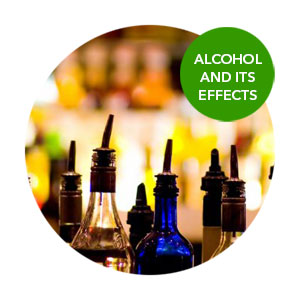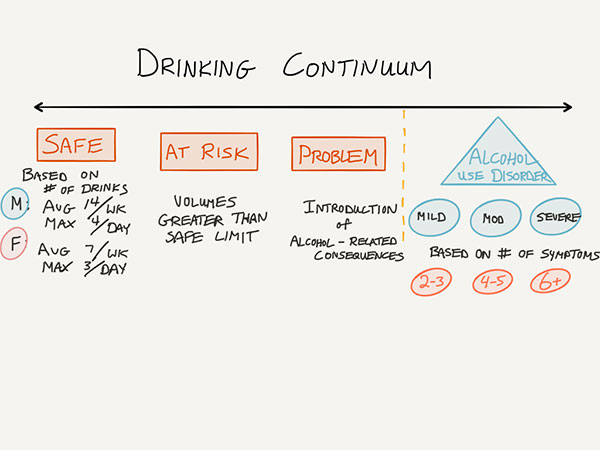ALCOHOL AND ITS EFFECTS
Play the audio version of this article:
According to 2012 data from the National Institute on Alcohol Abuse and Alcoholism, approximately 56% of Americans report alcohol consumption. Further details about drinking patterns get stratified based on race and gender. Given all the alcohol consumed, the Center for Disease Control has developed some primary guidelines to quantify drinking into units and to describe a spectrum of drinking from minimal harm to severe harm. As amounts consumed increase, tolerance also increases, and this is a cardinal symptom in the development of alcoholism.
The NIAAA shows the following different measures of a standard alcohol drink:
- 12 ounces of regular beer, which is usually about 5% alcohol
- 5 ounces of wine, which is typically about 12% alcohol
- 1.5 ounces of distilled spirits, which is about 40% alcohol
So, to convert these amounts to what you might purchase at the store, you get the following bulk numbers:
- 1 bottle of wine has approximately 5 glasses in it, or 5 standard drinks
- A pint of liquor (500 mL) has 11 standard drinks
- A 750 mL bottle of liquor (often called a ‘fifth) has approximately 17 shots in it, or 17 standard drinks
- A 1.75 mL bottle of liquor (a handle) has about 39 standard drinks
Acknowledging Volume
Sometimes, just understanding the actual volume of alcohol you’re consuming can make a big difference in behaviors. Many people will under-report drinking amounts out of embarrassment, confusion, or not knowing the correct conversions. No matter the feelings behind the drinking, tolerance is tolerance. This involves your brain and body adapting to alcohol volumes to be able to consume more and more over time.
Withdrawal
Alcohol withdrawal is when the nervous system reacts, sometimes in a violent way, to abstinence from alcohol. Remember that the brain has adapted to drinking high quantities of alcohol and can actually become more comfortable ‘on’ alcohol than ‘off’ it. Severe withdrawal from alcohol can be life-threatening and will need the medical care of experts. These are some of the things to watch for:
- Shakiness and tremors
- Poor balance and difficulty walking
- Confusion
- Nausea or Vomiting
- Sensitivity to light
- Strange sensations such as hearing voices or feeling your skin crawl
The most extreme alcohol withdrawal can cause a seizure or outright delirium and many people die from these things every year. If you have experienced seizures in the past, quitting drinking alcohol may be best under the supervision of a physician in medical detox.
Many people drink and some of them drink heavily without many problems. How do we know where the ‘line in the sand’ actually is in regards to alcohol consumption? What’s the difference between a ‘heavy drinker’ and an alcoholic? Does the term ‘functioning alcoholic’ hold water?
The Drinking Continuum
We use a spectrum approach to describe different drinking patterns and risk groups. There is an important ‘line in the sand’ for this topic, and across that line is where a diagnosis of Alcohol Use Disorder lies. The three patterns of drinking before this line are termed:
- Safe Drinking – This style of drinking is really about healthy limits of alcohol consumption. It is the recommended target for American men and women according to the CDC and many doctors will encourage people to stick to these guidelines. The safe limits for a man are an average of 14 drinks per week and a maximum any day of 4. For a woman, the limits are an average of 7 drinks per week and a maximum of 3 per day.
- At-Risk Drinking – This form of drinking is in excess of the quantities outlined above but without the consequences and dysfunction present with an alcohol use disorder. Classically, this person would be the ‘Heavy Drinker.”
- Problematic Drinking – This zone is where the person has experienced a significant consequence of drinking. This could include a DUI arrest, losing a job due to being drunk or hungover, or significant marital discord connected to drinking patterns.
Alcohol Use Disorder
As we cross this line, we now introduce the diagnosis of an Alcohol Use Disorder. This condition is defined by clinical symptoms (11 in total) and significant life problems. As a health condition, it is also labeled as Mild, Moderate, or Severe based on how many symptoms are present. For our purposes, we will list the five most important symptoms as they are distinct and easy to understand.
- Tolerance
- Withdrawal
- Loss of Control around Drinking
- Continuing to Drink Amidst Severe Life Problems or Consequences
- Cravings to Drink
Minimizing and the Acceptance Hurdle
We have established cutoffs for the limits of drinking alcohol, we have stratified alcohol use on a spectrum, and we have identified the core symptoms present in an Alcohol Use Disorder. One of the most common problems encountered when evaluating people is that the ‘shaping’ of the diagnosis is very much based on the self-report by the person.
For instance, when couples present for an evaluation of one partner possibly struggling with alcoholism, it is almost certain that the person will self-identify not quite across the line for Alcohol Use Disorder and present that they are in the Problematic Drinking category. The stigma of actually having an Alcohol Use Disorder is too great for most people at first. Interestingly, the other partner typically disagrees and will say something like “I think you’re minimizing things!”
The truth really exists within you, so please be honest with yourself. There are many people who felt that they were in a ‘safe zone’ for drinking and not actually an alcoholic, just to learn over a decade of suffering that they were horribly wrong. They had a distorted view of their problem and thought they were in control when, in fact, they were entirely out-of-bounds.
Alcoholism is a disease and we can do something about it. For many people, the goal of true acceptance of their disease is make-or-break when it comes to chances at success. A commitment to do the right things in recovery can sometimes be easy once that authentic acceptance hurdle has been crossed.
Read more CeDAR Education Articles about Alcohol and Its Effects.





